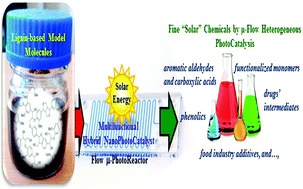Selective photocatalysis of lignin-inspired chemicals by integrating hybrid nanocatalysis in microfluidic reactors
Abstract
This tutorial review assesses the available and possible strategies for attaining higher selectivity and yield of value-added chemicals from lignin using nanocatalysts embedded in a photomicroreactor. The design of the photomicroreactor, the choice of photocatalysts and the techniques for assembling the catalysts in such confined spaces are crucial elements. Lignin, a predominant industrial byproduct and pollutant, has been recognized today as a rich reservoir for aromatic chemicals and a prominent resource. The conventional batch photocatalytic studies on lignin, often using dissolved lignin under alkaline conditions, often generates a wide range of valuable organic chemicals which find applications in the pharmaceutical, food processing, cosmetic and fine chemical industries. The role of photocatalysis in such lignin depolymerizations is questionable as the dissolution procedure initiates fragmentation of lignin prior to light exposure. The complexity of the lignin structure also impedes necessary and decisive information to understand the reaction mechanism during such reactions in batch photoreactors. Considering these facts, photocatalysis studies on lignin entail a thoughtful reevaluation and focus on understanding the role of photocatalysis in the product generation and authenticating the implicated reaction mechanisms. The development of a photocatalytic system for lignin depolymerization in a continuous microreactor is a superior approach for the generation of valuable products emanating from lignin depolymerization and the successful execution of such strategies can pave the way for the commercialization of bio-based chemicals.



 Please wait while we load your content...
Please wait while we load your content...